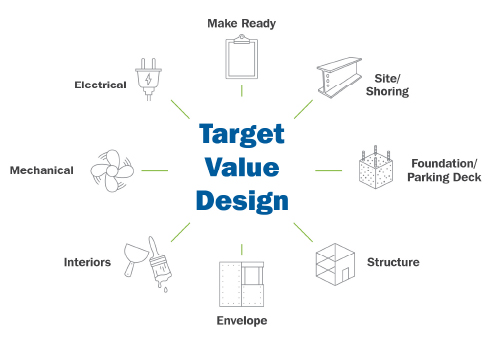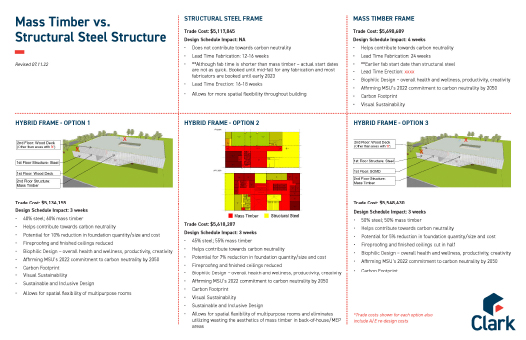Capabilities Lean Construction
Expertise and Value, with Less Waste
Applying our knowledge of Lean Construction principles and our experience of professional services eliminates waste and delivers a superior value to our clients.
Applying our knowledge of Lean Construction principles and our experience of professional services eliminates waste and delivers a superior value to our clients.

Lean Construction practices provide opportunities for efficiency improvements in several key areas. Additionally, lean principles allow for efficiencies that are not possible with typical or conventional methods.
The following examples show how we apply lean construction practices and principles to our projects in order to create this kind of efficiency.
In the past, project schedules were wildly optimistic, with an average of only 55% of work promised within a week actually being completed as stated. This leaves subcontractors waiting for other dependent tasks to complete before new work can proceed.
We utilize a Pull Planning process with the trade contractors on a weekly basis. Pull Planning reverse engineers scheduling based on the required end date. Trade contractors provide critical dates and input and a project schedule board is prepared. Daily and weekly tasks are identified, color coded and maintained for overall progress. This form of scheduling allows us to create a predictable workflow and stabilize the project environment, reducing both time and cost without sacrificing quality.
When rooms, assemblies, and other aspects of a design lack coordination, inefficiency increases for a variety of reasons.
Our process unitizes these specific assemblies or rooms within the design. This modularization, coupled with off-site fabrication, allows for improved quality, reduced costs, and a reduction in the time needed for installation. The goal is to improve system-wide performance, improve quality, and allow compressed schedules to be attained.
TVD completely changes the traditional, inefficient method of designing and budgeting projects. With early involvement of our Pre-Construction Department and trade partners can help inform the project design decisions. Instead of budgeting a completed design, the project is broken up into smaller budget components and designed to those budgets. This process, coupled with Choosing By Advantages are two lean construction techniques that help ensure that the project budget is spent in a way that will maximize their impact to the project.


CHOOSING BY ADVANTAGES (CBA)
CBA is a concept that has its roots in Integrated Project Delivery (IPD). The primary purpose of the CBA process is to help project stakeholders compare alternatives based on their differences. To avoid double counting, decisions are based on the positive attributes, not advantages vs. disadvantages. The importance of these differences are weighted by their importance. This allows the project team to make decisions that are based on relevant facts to arrive at the best solution for the project.
PULL PLANNING
Pull Planning is another lean construction technique that makes project scheduling a collaborative process rather than the authoritarian approach that is often the case with traditional Construction Manager dictated Critical Path Management scheduling. Pull Planning engages the trade partners on a weekly basis. Based on a required end date, we integrate critical dates and input from all the trade partners. The schedule is developed on a large project board and daily and weekly tasks are identified, color coded and maintained for overall progress. The input received from all trade contractors collectively allows us to schedule the project at a detailed level while maintaining a critical completion date. Aggressive scheduling is maintained, while planning the work collaboratively with trade partners allows us to maintain the project schedule and cash flow. Instead of pushing a project to completion our entire project team “pulls” the project together to completion.


DESIGN ASSIST (DA)
Our Design Assist process is mature, transparent, and time-tested with proven results. Using this approach, we retain trade partners very early in the project to help assist other project team members in developing the design. We have developed an approach that maintains a competitive procurement process while reaping all of the benefits of the DA process.
Some of the benefits of our Design Assist approach include:
Helps create a collaborative culture
Allows for an early start on BIM
Competitive Bid/Award at Design Development to critical trades
Provides early budget awareness
Minimizing Risk
Reduce Project Cost
Promotes Owner’s Facilities Team collaboration
Allows suppliers to interface with the final design documentation
BUILDING INFORMATION MODELING (BIM)
How we visualize and build commercial buildings has dramatically changed in recent years. Building Information models are computer-based three dimensional models of the building components. These models provide information about the physical arrangement and the functional performance of the building. BIM allows project stakeholders to interact with spaces before they are ever constructed in reality. Building energy performance, lighting, airflow, etc. can all be evaluated as well. The BIM model can continue to be used after the building is completed for the facility’s maintenance staff to locate things like filters, valves, and maintenance schedules.

If you're interested in learning more about our company, our services, and how we can work together on your construction project, let’s start a conversation today.
Connect With Us